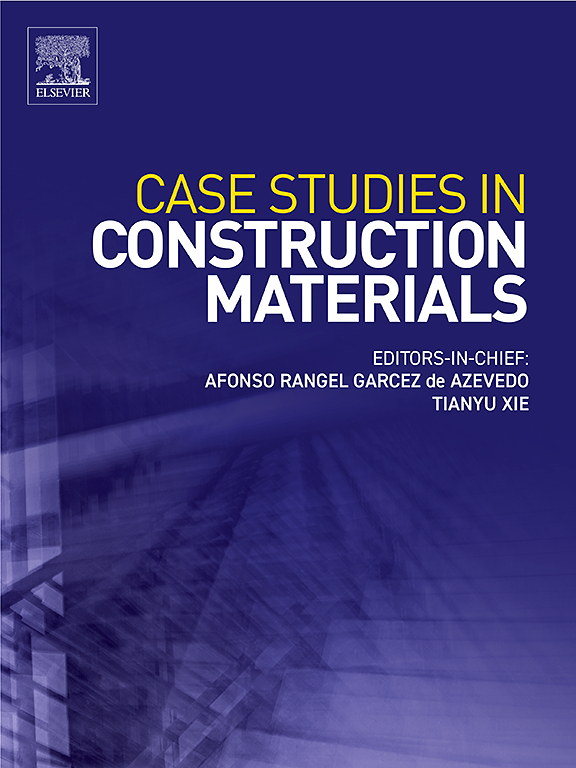Evaluation of the dynamic modulus and fatigue cracking properties of polyethylene /aramid fiber asphalt mixture based on the S-VECD theory
IF 6.6
2区 工程技术
Q1 CONSTRUCTION & BUILDING TECHNOLOGY
引用次数: 0
Abstract
Fatigue cracking is a primary distress in asphalt pavements, and the fatigue cracking performance can be enhanced through the addition of aramid fiber. In this study, the viscoelasticity of a polyethylene/aramid fiber asphalt mixture (PAAM) was investigated using the simplified viscoelastic continuous damage (S-VECD) theory, and the fatigue damage evolution of PAAM was analyzed. The FlexPAVE™ program was employed to evaluate the fatigue performance of fiber-reinforced asphalt pavement. The results indicated that the increase in air voids led to a decrease in the viscoelasticity and fatigue cracking resistance of PAAM. Compared with other mixing methods, the viscoelasticity and cracking resistance of PAAM with three-layer coarse aggregate dispersion method (TLC) were significantly improved. An increase in fiber content led to a gradual deterioration in fatigue performance of PAAM. In addition, the aging modulus ratio (AMR) increased with increasing temperature, and the impact of aging on the viscoelasticity of PAAM was more significant at high temperature. The results of the FlexPAVE™ program showed that the cracking percentage of fiber-reinforced asphalt pavement with TLC method was reduced by 44 % compared with the TRA method. In addition, compared with the non-fiber asphalt pavement, the cracking depth of fiber-reinforced asphalt pavement was reduced by 65 %, 81 %, 91 %, and 76 % after aging periods of 1, 2, 4, and 7 days, respectively. This study provides a theoretical basis for improving the application of aramid fibers in asphalt pavement using the S-VECD theory.
基于s - veecd理论的聚乙烯/芳纶纤维沥青混合料动态模量及疲劳开裂性能评价
疲劳开裂是沥青路面的主要病害,通过添加芳纶纤维可以提高沥青路面的疲劳开裂性能。采用简化粘弹性连续损伤(s - veecd)理论研究了聚/芳纶纤维沥青混合料(PAAM)的粘弹性,分析了PAAM的疲劳损伤演化规律。FlexPAVE™程序用于评估纤维增强沥青路面的疲劳性能。结果表明,空气空隙的增加导致PAAM的粘弹性和抗疲劳开裂性能下降。与其他混合方法相比,采用三层粗集料分散法(TLC)的PAAM的粘弹性和抗裂性明显提高。随着纤维含量的增加,PAAM的疲劳性能逐渐恶化。老化模量比(AMR)随温度升高而增大,高温下老化对PAAM粘弹性的影响更为显著。FlexPAVE™程序的结果表明,与TRA方法相比,采用TLC方法的纤维增强沥青路面的开裂率降低了44 %。此外,与非纤维沥青路面相比,纤维增强沥青路面经过1、2、4、7天的老化后,裂缝深度分别减少了65 %、81 %、91 %和76 %。本研究为利用s - veecd理论提高芳纶纤维在沥青路面中的应用提供了理论依据。
本文章由计算机程序翻译,如有差异,请以英文原文为准。
求助全文
约1分钟内获得全文
求助全文
来源期刊

Case Studies in Construction Materials
Multiple-
CiteScore
7.60
自引率
19.40%
发文量
842
审稿时长
63 days
期刊介绍:
Case Studies in Construction Materials provides a forum for the rapid publication of short, structured Case Studies on construction materials. In addition, the journal also publishes related Short Communications, Full length research article and Comprehensive review papers (by invitation).
The journal will provide an essential compendium of case studies for practicing engineers, designers, researchers and other practitioners who are interested in all aspects construction materials. The journal will publish new and novel case studies, but will also provide a forum for the publication of high quality descriptions of classic construction material problems and solutions.
 求助内容:
求助内容: 应助结果提醒方式:
应助结果提醒方式:


